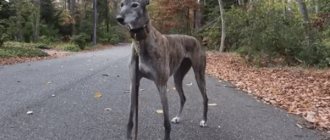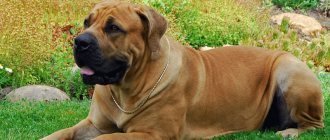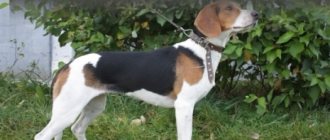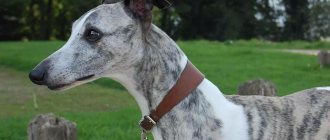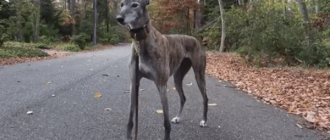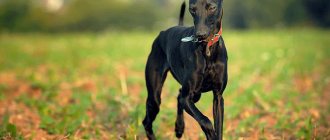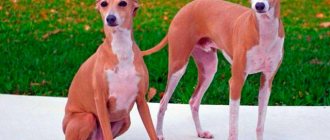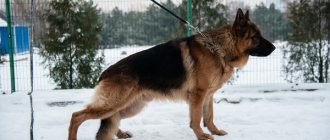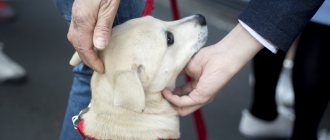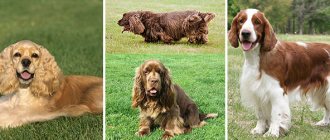Greyhounds are famous for their speed. Previously, they were specially kept at royal courts for hunting deer, rabbits and hares. It was not at all difficult for the dog to catch the nimble game in a couple of seconds. Now these dogs are no longer bred for hunting purposes. Owners value their greyhounds for their incredible grace and great intelligence. Although the ability to accelerate to enormous speeds does not go unnoticed - representatives of the breed are used in “greyhound racing” (greyhound racing is one of the favorite events in the UK).
- 2 Appearance standards
2.1 Video: Greyhounds in motion - 2.2 Photo gallery: colors acceptable for greyhounds
- 6.1 How much do greyhounds cost?
Breed standard and description
English greyhounds are usually divided into 3 types:
- Hunters;
- Runners – participate in dog racing;
- Exhibition dogs are representatives of the breed that meet breed standards.
Weight: 30 kg; Height at withers: 70-75 cm.
Body: Looks lean and muscular.
Skull: flat. Curve as it transitions from forehead to nose.
Eyes: oval shaped, brown.
Ears: small in size, thin, slightly raised on cartilage.
Neck: long, muscular
Chest: wide.
Ribs: visually defined, deep.
Belly: tucked in.
Paws: long, smooth, muscular.
Back: rectangular. The spine has an arched shape. Elevation in the lumbar region.
Tail: carried low and long. Its tip is narrowed relative to the base.
Coat: Short, fine and soft. Without pronounced undercoat.
The peculiarity of dogs of this breed is long jaws with a scissor bite.
Color: black, white, red, blue, fawn, fawn, brindle, harlequin. A combination of colors with white spots is allowed.
Disqualifying features
- Deviations from breed standards;
- Aggressive behavior;
- Cowardice;
- The presence of congenital defects of a physical or psychological nature.
For what disqualifications can a dog be rejected?
To obtain a certificate from the canine society for participation in exhibitions and breeding of the breed, you must undergo an examination for compliance with standards. There are “non-strict” deviations, in which the document will not be refused, but the dog will be classified as a breeding class (the price of puppies will decrease significantly, the chances of winning in competitions are low).
A show-class Greyhound, that is, meeting all breed standards, can take part in exhibitions
Here is a list of strict disqualifications (reasons why a Greyhound will not be able to take part in exhibitions and participate in breeding):
- violation of the sexual type (too large bitch or too light male);
- excessive aggressiveness towards humans and other dogs;
- excessive cowardice;
- too short blunt muzzle and rounded cranial part of the head;
- snack or undershot;
- tail too short;
- long wool;
- short legs;
- blue or green eyes, light nose with spots.
The puppy can have blue and gray eyes, but by the age of one year they should darken
History of the English Greyhound
It is believed that the English greyhound is a direct descendant of the Saluki or Sluggi, the very first domestic dogs. But genetic research in 2004 showed that greyhounds are related to sheepdogs and are not related to Salukis.
The most plausible version says that the English greyhound descended from the Celtic greyhound, . Celtic tribes brought them to the British Isles around the 5th century BC.
It is known for certain that already in the 10th century the English greyhound was a favorite breed among aristocrats. According to the Forest Law, issued in 1014, only members of the nobility were allowed to keep greyhounds.
In 1776, the first British hunting club was opened by Lord Orford, a passionate hunter, breeder and breeder. He infused the Greyhounds with the blood of the Old English Bulldog . As a result of the experiment, the animals strengthened their bones , but their appearance remained the same.
Subsequently, greyhounds were divided into 3 subtypes: hunting, racing and exhibition. It is worth noting that dogs of different subtypes are prohibited from crossing with each other. Thanks to this, greyhounds are considered the property of the English kingdom.
Mating
For mating, you need to find a partner of the same content category. The process should take place in a familiar environment for the dog. It is best to breed dogs after the female's third heat, which occurs at approximately 2 years of age .
It would be appropriate to first let the dogs get to know each other better and go through the entire courtship process.
Since dogs are very shy, it is necessary to leave them alone. This breed is very delicate. Typically the process takes from 20 minutes to an hour . Breeders need to look at their pets from time to time. This is necessary so that during the “lock” the dogs do not harm each other.
Who is the Greyhound suitable for?
Depending on the breed subtype, the owner must be:
- hunter;
- a fan of greyhound racing;
- participate in dog shows.
Greinhounds are hunting dogs and are not suitable for service or home guarding. Some people believe that dogs of this breed have a crazy character. But they are more balanced than terriers. They like to be close to a person ; if left alone, the pet becomes lethargic and sick.
Greyhounds love their family . They sense the mood of their owners and are unobtrusive. Owners note that these dogs detect changes in the intonation of the owner's voice. Also, pets do not tolerate rude treatment.
Greyhounds get along well with children , as well as with other animals in the house. But rather, this concerns relationships with dogs and cats; birds and rodents awaken the hunters in them. Therefore, the guinea pig will have a hard time.
Psychology
Before describing the qualities of the Greyhound breed, we would like to make some reservation. This dog should not be confused with the Italian Greyhound, which is also called the Italian Greyhound.
The development lines of these breeds are very different.
They are united by one of the theories about the origin, which claims that the ancestors of Italian Greyhounds also lived in Ancient Egypt, as well as obvious external similarities. But these are different breeds.
So, what can a Greyhound dog do to please its owners?
- Mind. Compared to other hounds , for example, Russian or Estonian , the gray simply demonstrates miracles of intelligence. He very sensitively captures and correctly interprets the intonations in a person’s voice. Exactly the same behavior has been observed in dogs of the Irish Wolfhound .
- Sensitive psyche. There are breeds of dogs that you should not yell at, including the Greyhound. Buying such a dog is an expensive pleasure. However, here you need to be prepared not only financially, but also morally.
Important! You must express your demands calmly and convincingly. It is absolutely forbidden to treat a dog rudely; it will simply refuse to respond to harsh measures, will be offended, and the connection with the owner will be lost.
- Good visual concentration. Unlike other hunting dogs, which rely primarily on their sense of smell, the Greyhound uses its vision deftly. This is his strong point in the pursuit of small prey.
Compared to other hounds, Gray demonstrates simply miracles of intelligence. He very sensitively captures and correctly interprets intonations in a person’s voice
- Equilibrium. You don't have to worry about the mood swings that greyhounds are famous for. Aristocratic manners when warming up at home may even seem somewhat sluggish to some.
- High adaptability. The dog tolerates loneliness calmly; he will not destroy everything around him. And when the situation changes, he will not rebel.
- Easy to learn. Even an inexperienced dog breeder can train a gray dog. A disobedient, angry and stubborn Greyhound is a great rarity and a strange misunderstanding.
- Contact. These dogs love to communicate, both with people and with their own kind. However, the dog will not impose itself if he sees that the owner is very tired after work.
When running, a greyhound becomes like a kangaroo
Maintenance and care
Greinhounds are lazy pets. They love to lie on the sofa. To prevent your pet from becoming completely lazy, you should walk him every day for at least an hour .
The Greenhound will be an excellent companion for joggers . When such walks become a habit, your pet will become more willing to go outside.
Due to the lack of undercoat, it does not tolerate frost . Therefore, for walks you need to get warm overalls.
Maintenance is easy. The fur once a week using a damp palm or rubberized glove. Once every 3 months, the pet is bathed using dog shampoo.
Healthy Greenhound eyes are shiny, without excessive tearing or souring. Once every 7-10 days they are examined and wiped with a cotton swab or disk soaked in warm water.
To keep your pet's teeth healthy, brush them once a week . To do this, use a special toothpaste for dogs.
The animal's paws should be washed after walks with a cloth or washcloth. They must be carefully inspected for mechanical damage.
Feeding
Greyhounds are generally unpretentious eaters and have a good appetite. Most breeders prefer premium food. You can feed your pet in a combined way, but you should not mix two types of food: natural and special food at one time.
For natural nutrition you should include the following products:
- Lean meats: chicken, turkey, rabbit, beef;
- Sea fish without bones;
- Boiled eggs (1 time every 7 days);
- By-products;
- Vegetables: cabbage, beets, carrots, etc.;
- Greenery;
- Cereals: rice, oatmeal, buckwheat;
- Vegetable oil – 1 teaspoon per day.
Before serving, the meat must be frozen at a temperature of -15-20 degrees for a minimum of 2 weeks. Before serving, it must be completely defrosted and doused with boiling water.
must have fresh, clean water freely available in a separate container.
It is forbidden:
- Boiled bones;
- Spicy, fried, sweets, smoked foods;
- Fatty meats;
- Raisins and grapes;
- Nuts and chocolate;
- Bony fish.
Feeding
The special structure of the greyhound's body contributes to its accelerated metabolism. Especially when the animal is exposed to physical activity: running, chasing, doing exercises. Hounds need a nutritious, balanced diet to maintain health.
Puppy
When feeding young animals, adhere to the following rules:
- Portions should be small - the animal is just getting used to the food. Increase the amount of food as your pet grows.
- The puppy should eat in a quiet place without extraneous noise or distracting movements.
- To help your baby get used to eating in the same place, set aside a special corner for meals - always place food there. The same dishes also contribute to habituation.
Dog food bowls
After eating, keep the animal calm - too active actions contribute to intestinal volvulus and regurgitation.
What foods should be included in the diet of a growing organism?
- dietary meat;
- low-fat milk;
- boneless fish;
- eggs;
- low-fat cottage cheese;
- porridge;
- vegetables.
Example of a puppy's diet
Don't forget about vitamin complexes and supplements of useful minerals. If you want to introduce your animal to food, consult your veterinarian to choose the best products.
Adult Greyhound
Divide meals into 4-6 meals per day for the animal - there should not be too much food in the bowl. Give preference to healthy natural products:
- lean meat and offal (heart, liver);
- eggs;
- boneless fish;
- porridge;
- dried pieces of bread;
- vegetables and fruits.
Adult Greyhound Foods
It is recommended to pre-clean the meat of fat. It is better to exclude pork from the diet - pay attention to chicken, turkey, rabbit, and game. Be sure to alternate meat with other products - it does not contain all the beneficial substances a dog needs. Porridge and bread should be of such a consistency that the animal can easily swallow them.
Important! Avoid long bones: their fragments can damage the oral cavity and digestive system. But you can give your dog harder bones - they help clean the teeth.
Raising and training a dog
The English greyhound is people-oriented, so house training does not cause trouble for the owner. Training a Greyhound to be completely submissive is a difficult task.
You can achieve results if you cooperate with a professional. Complex commands will have to be learned with a dog handler.
If nothing complicated or supernatural is required from your pet, then you can train the puppy yourself. The main thing is that the animal trusts its owner.
Health and life expectancy
Representatives of the Greyhound breed have enviable health and live up to 14 years . They rarely have hip dysplasia, which is common in other long-legged dog breeds.
Common diseases:
- Cataract;
- Progressive retinal atrophy;
- Anomaly in the development of the tear ducts;
- Age-related arthritis;
- Deafness (white dogs);
- Hypothyroidism;
- Allergic reactions to medications.
Attention! Dogs of this breed are susceptible to cancer in bone tissue. It is worth contacting a veterinarian if your pet develops lameness.
Tips for choosing a puppy
When purchasing a Greyhound puppy, start by finding a good kennel. In this case, it would be a good idea to read reviews on numerous forums on the Internet. You can invite an experienced owner of this breed or a dog handler to meet your baby for the first time, who will help you make the right choice.
Take an interest in the achievements of the puppy's parents. As a rule, inheritance of the talents of ancestors occurs at the genetic level. You should look for a racing dog at film shows, a puppy for showing - at specialized exhibitions, but a future hunter will appear only with parents working in the field. Greyhound puppies for home keeping do not require such close attention to pedigree.
The price for a puppy will depend on its pedigree, line standards, exterior and popularity of the kennel.
Breed photo
A selection of photos of the English greyhound.
